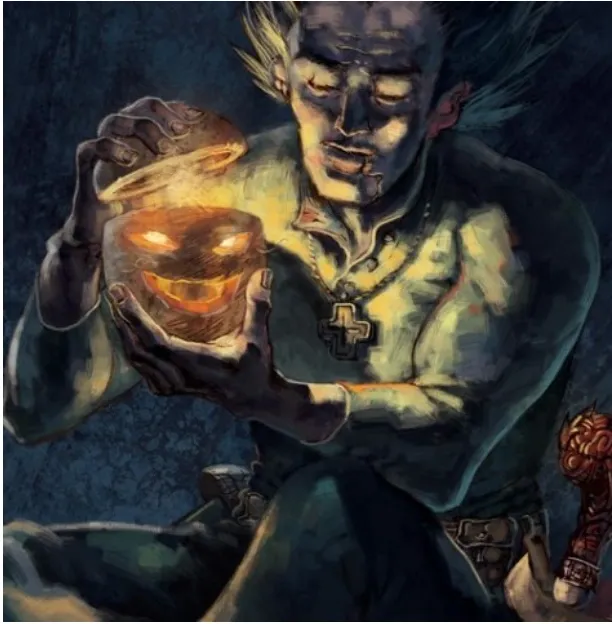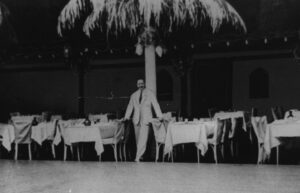
A good number of years ago in Ireland, a fellow known as Stingy Jack maintained less than a stellar reputation. Stingy Jack derived tremendous pleasure in playing tricks on all. He fooled villagers and travelers alike. He tricked his family members. On occasion, he even pranked his own mother. Few enjoyed the company of Stingy Jack who appeared deficient on goodwill toward his fellow man rather than stingy with his purse.
Adding to this charming persona, Stingy Jack was a drunkard who spent most of his free time at the local pub. While at the pub with the Devil himself, Stingy Jack took the Devil up on an offer for drinks. Stingy Jack only had to agree to give his soul to the Devil for the drinks. Stingy Jack asked how the Devil would pay for the drinks. The Devil changed himself into a coin to pay for the drinks. Stingy Jack, always the trickster, placed the coin in his pocket next to a cross. Being stuck beside a cross, the Devil lost his powers and remained a coin in Stingy Jack’s slacks.
The Devil pleaded for his freedom and offered not to take Stingy Jack’s soul at least not until Stingy Jack died. Stingy Jack freed the Devil, only to encounter the Devil years later in an apple orchard. The Devil sought payment of Stingy Jack’s soul. Stingy Jack said he was ready, but requested an apple from a nearby tree as his last wish. The Devil climbed the apple tree to retrieve an apple. Stingy Jack quickly carved a cross into the tree thereby once again trapping the Devil high up in the apple tree.
Apparently with a little self-reflection on his life until that moment, Stingy Jack demanded that his soul would never pass into Hell after Stingy Jack died. It appears that Stingy Jack recognized his immortal need for insurance. The Devil agreed in order to secure his freedom.
Years later, Stingy Jack died and traveled to the Pearly Gates of Heaven. Saint Peter greeted Stingy Jack advising that there would be no admittance to Heaven as Stingy Jack spent his life miserably and in a cruel fashion. Stingy Jack wasted his life and his worthless nature did not merit entrance to Heaven. Not knowing where to turn, Stingy Jack showed up at the gates of Hell. The Devil, true to his word, denied Stingy Jack entrance to Hell, although the Devil certainly believed that Stingy Jack belonged there.
Stingy Jack shrewdly avoided eternal damnation in Hell. Yet, he ignored the other half of the equation and continued with his less than heavenly approach to life while on Earth.
Stingy Jack asked what would happen to him with the Devil replying that Stingy Jack must eternally wander the Netherworld between Heaven and Hell. Stingy Jack complained that the Netherworld presented total darkness and Stingy Jack could not see his way. The Devil tossed Stingy Jack an ember from the fires of Hell to light Stingy Jack’s way. Stingy Jack carved out a rutabaga and placed the eternal ember in the hollow root vegetable to light his path. From that day forward, Stingy Jack would forever roam the Earth without a resting place with his dimly lit rutabaga as his only light.
The Irish thereafter called Stingy Jack “Jack of the Lantern” which, when shortened, became “Jack O’Lantern”.
On All Hallow’s Eve, the Irish would carve out rutabagas, turnips or gourds and place a lit candle inside the vegetable to ward off Stingy Jack and other evil spirits. This tradition continued for centuries with a slight change in the mid-1800s. The new Irish immigrants to the United States quickly recognize that pumpkins much better fit the bill for carving at Halloween than rutabagas and turnips. The Irish back in the homeland did not use pumpkins as no pumpkins were grown in Ireland. The modern Jack O’Lantern became a staple of the Halloween celebration.
But how did Stingy Jack become associated with Halloween itself? His story stands apart from All Hallow’s Eve. The lessons we may learn from his life do not readily tie into Halloween. The “scary” side of Halloween’s history may shed more light on the Stingy Jack’s eternal wandering, at least more light than a dimly lit rutabaga.
The Celtic pagan ritual of Samhain celebrated each October 31, recognizes the end of summer and beginning of the darker months ahead. At this time between seasons, the spirit world among us becomes visible. Spirits could freely travel with us and cause supernatural mischief. The spirits needed to be appeased and avoided. The tradition of leaving food, wine and treats for the deceased spirits arose as a bribe for the spirits to leave us alone. Soul cakes, the precursor to candy treats, would be prepared and left out. But more would be needed to ensure our own well-being.
Disguises in the form of masks and frightening costumes would fool the spirits. The spirits would avoid anyone so dressed up as they would falsely believe them to be just another spirit. The scarier the costume, the better the odds of surviving All Hallow’s Eve.
In these traditions, an old guy eternally walking the Earth carrying a rutabaga with an ember from Hell as his lantern found a home. Stingy Jack may not be welcome in Heaven and may be precluded from Hell, but he fit right in with the Samhain crowd, at least one night a year.
In honoring Stingy Jack and perhaps even more as an effort to keep him at distance, we carve pumpkins into Jack O’Lanterns. Those perfectly stenciled pumpkin carvings with intricate patterns and detail may nicely shine on walkways. Yet, it strikes me that such Jack O’Lanterns may be ineffective in dealing with Stingy Jack. Going forward, I am in the camp of those poorly carved, can you tell if it is even a face, Jack O’Lanterns. A Jack O’Lantern should be the result of a child envisioning a perfectly scary face then butchering a pumpkin to the point that the eyes are uneven, an off-center hole is the nose, and the mouth has but one large tooth. That type of Jack O’Lantern would be Stingy Jack worthy!
In Estate Planning, when considering disinheritance of someone, we may encounter the Stingy Jack client. That client starts off with a firm position that one child must be disinherited. I never ask for details regarding such relationships and instead focus on the methods of disinheritance and risks presented to estate plan documents if not done properly. Nonetheless, these clients feel it imperative to explain the reasons for disinheritance. My office becomes a confessional.
As the planning process unfolds and that Stingy Jack client ponders these actions more deeply and prepares to set forth that disinheritance position in stone (or at least on paper in a trust), a little self-reflection may soften the rough edges. A number of these clients come back to a less than full disinheritance position. Nothing has changed between the client and the estranged family member. No reconciliation has taken place. Yet, something fundamental changed. Perhaps these clients have their own Stingy Jack moment where they think they need some insurance against a drastic decision. I would like to believe that the change is made out of affection for the wayward family member rather than securing a Stay Out of Hell card.
This Halloween, in addition to rooting for the poorly carved, scary looking pumpkins, I also will cheer for the more authentic costumes. Our doorstep has been visited by way too many Spidermen and princesses the past few years. Those kids are cute, for sure, but those lame costumes will not frighten away the mischievous spirits. I say, any kid who shows up with a scary mask and frightening costume gets an extra piece of candy. If a daring child knocks on our door dressed as an old man toting a carved out dimly lit rutabaga, that kid should get all the candy. Enjoy your own Trick or Treating.




